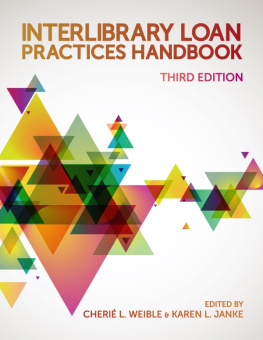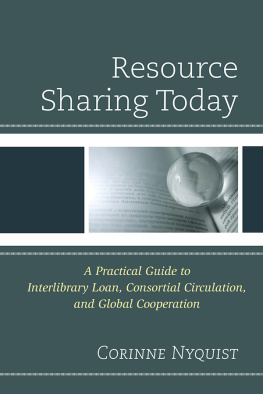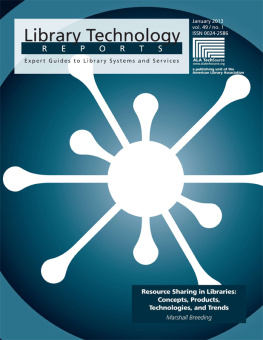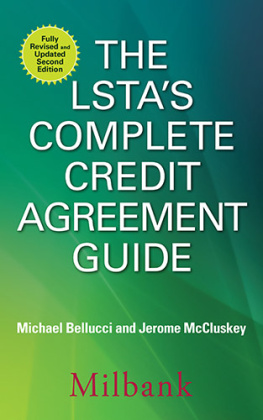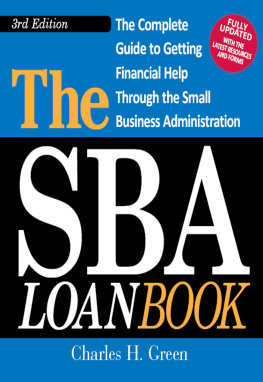ALA Editions purchases fund advocacy, awareness, and accreditation programs for library professionals worldwide.
INTERLIBRARY LOAN PRACTICES HANDBOOK
THIRD EDITION
Edited by Cheri L. Weible and Karen L. Janke
AMERICAN LIBRARY ASSOCIATION CHICAGO 2011
Cheri L. Weible is head of Interlibrary Loan and Document Delivery at the University of Illinois at Urbana-Champaign and has been in the department for eleven years. Cheri is an associate professor at the university and has published twenty-four articles, presented twenty-five papers and lectures, and consulted for ILL operations workflow on a professional level. She holds an MA in history from Pittsburg State University (Kansas) and an MS in Library and Information Science from the University of Illinois at Urbana-Champaign.
Karen L. Janke is the library director at Erikson Institute, a graduate school in child development located in downtown Chicago, where she has worked since July 2009. Previously, Karen was an associate librarian and team leader for Access Services at Indiana University-Purdue University Indianapolis, where she worked for eight years in Interlibrary Loan and Access Services after receiving her MLS from the University of Illinois in 2001. She has coauthored two articles for the Journal of Interlibrary Loan, Document Delivery and Electronic Reserve on article delivery turnaround time and management issues as well as a forthcoming article in the Journal of Popular Culture.
2011 by the American Library Association
All rights reserved except those which may be granted by Title 17, Sections 107 and 108, of the United States Code.
While extensive effort has gone into ensuring the reliability of the information in this book, the publisher makes no warranty, express or implied, with respect to the material contained herein.
ISBNs: 978-0-8389-1081-8 (paper); 978-0-8389-9294-4 (PDF); 978-0-8389-9295-1 (ePub); 978-0-8389-9296-8 (Mobipocket); 978-0-8389-9297-5 (Kindle). For more information on digital formats, visit the ALA Store at alastore.ala.org and select eEditions.
Library of Congress Cataloging-in-Publication Data
Boucher, Virginia, 1929
Interlibrary loan practices handbook / [Virginia Boucher] ; [edited by] Cheri L. Weible and Karen L. Janke. 3rd ed.
p.cm.
Includes bibliographical references and index.
Previous ed.: 1997.
ISBN 978-0-8389-1081-8 (alk. paper)
1. Interlibrary loansUnited StatesHandbooks, manuals, etc. I. Weible, Cheri L. II. Janke, Karen L. III. Title.
Z713.5.U6B68 2011
025.62dc23
2011017433
Cover design by Casey Bayer.
CONTENTS
Margaret W. Ellingson and Susan D. Morris
Denise Forro
Amy R. Paulus
Cindy Kristof
Jennifer Kuehn
Tina Baich and Erin Silva Fisher
Cyril Oberlander
When I stepped into interlibrary loan (ILL) at the University of Colorado at Boulder Libraries in 1967, the service was open only to faculty and graduate students. Reference sources, especially bibliographies, were important as a source of information. Locations for libraries holding materials were discovered at a statewide center (union card catalog), the National Union Catalog, or the Library of Congress. Typewritten four-part paper forms were a great way to send and keep track of requests. There was no OCLC or other electronic ILL system. There was a national ILL code but no Colorado code. There also seemed to be nobody at all whom I could ask for enlightenment concerning ILL.
As the years slipped by, I learned enough to help others. I conducted many workshops, gave speeches, organized conferences, and did a two-day seminar at the University of Wisconsin School of Library and Information Studies nine different times. The Interlibrary Loan Practices Handbook was published twiceonce while I was working and once after retirement. (By the way, the current cat is all black and named Zorro.)
Since my retirement the ILL world has changed dramatically. The individuals need for information (and entertainment) has continued unabated while methods for producing materials seem to proliferate daily. One must keep up with all new developments. This book will give a current perspective and help for the neophyte.
A constant remains, however, and it is the most important thing about ILL: people. Those who need the materials and those who supply them are an endless panoply of interest and sometimes excitement. And so, to quote myself: Cherish your family, value your colleagues, and whether it be in person or electronically, treat kindly those who come to you for help.
Virginia Boucher
Professor of Libraries, Emerita
University of Colorado at Boulder
I was both surprised and honored when I was approached to produce the third edition of the ILL Handbook. Unlike Virginia Boucher who single-handedly created two wonderful editions, I felt that I needed to call on a little help from my ILL friends. The first person I contacted was Karen Janke, a trusted colleague, a good writer and editor, and someone I knew I could work with well. Thank you, Karen, for helping to make this edition of the ILL Handbook happen!
This edition of the handbook covers the basics of ILL and is aimed at the new practitioner as well as those who have suddenly found themselves responsible for an ILL unit. We didnt want the writing to be overly prescriptive, but we did want enough basic details so that someone who found himself or herself working in an ILL unit would have some idea of how to get through the job!
I also want to thank each of our chapter contributors. We chose a variety of contributors, some who have been in the field for decades and some newer, because fresh ideas and new energy are always valued in ILL. We and the chapter authors have a combined 158 years of experience in ILL!
Cheri L. Weible
I became an ILL practitioner exactly ten years ago, quite by accident: I was a graduate student at the University of Illinois Graduate School for Library and Information Science, I needed a summer job, and the ILL department was hiring. However, I quickly learned to love the chaos: requests were constantly coming in and there was always something to do. The process of interlibrary loan captured my imagination, and perhaps the simplest thing inspired me to think about the work I was doing in my library and what was happening in libraries all over the world. The simple thing was the ILL request number created when you submitted a request on the OCLC ILL system. This was back in the day of OCLCs Prism. Using that program made me feel like I belonged to a keystroke-based, command-driven secret society: 3,2,2,1 or 4,4 anyone? Even if you were a savvy searcher and fast typist, hundreds or thousands of new requests could be created by other libraries in the brief moments between your requests. And you knew this because of that request number, the sequential indication of just how busy we all were. You know youre an addict when you start to daydream what it might take to achieve the ultimate: sequential ILL request numbers.
Another amazing realization was that interlibrary loan was the concept of a lending library writ large: libraries sending their materials simply because another library submitted a request, and trusting that they would be returned unharmed. No user was at a disadvantage if her library didnt have the specific item she needed, because in the vast majority of cases another library was willing to help. At times I felt that it was a small miracle that a request could be filled at all. Given that so many people touched some aspect of a request from beginning to end, it seemed that there was a lot of room for error. But all it takes is one library to say yes. In the ten years since then, I have learned so much from other interlibrary loan colleagues. We are a creative, collaborative group of people, and we succeed in our mission of meeting our patrons needs because of each other. Even though technological advances have revolutionized the mechanics of the ILL request process in the past ten years, the spirit of trusting and helping remains.

